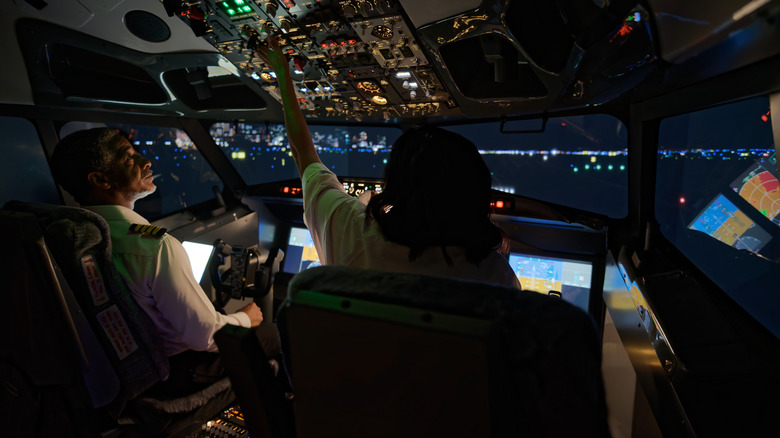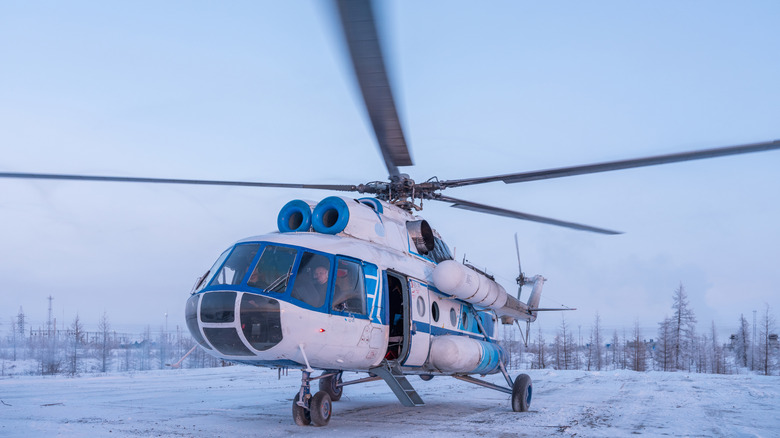What Is A Deadstick Landing & How Do Pilots Pull Them Off?
A regularly scheduled passenger plane can give a bit of a bumpy ride during even the most textbook landing. But a deadstick landing is a different beast entirely. The Collins Dictionary provides frank, and rather terrifying definition: "A landing of an airplane or space vehicle with the engine cut off." The term dates back to the 1930s, a time when the vital propeller of an airplane could cut out and leave the pilot with nothing but a piece of ineffectual dead wood doing nothing to keep them airborne. This didn't leave them entirely helpless, though — pilots of the day were actually trained to land under these conditions.
Even today, this is one of those eventualities that, though very unlikely, pilots and flight crews must still be able to manage. Doing so is a matter of assessing the situation, controlling the gliding descent of the aircraft, and leading it toward a viable spot in range for an emergency landing. This is as true in peacetime as in wartime, whether you're flying a modern day passenger jet such as the Boeing 747 or a World War II fighter jet. Helicopters, too, are capable of their own variation of a deadstick landing, in which enough rotor speed is retained to allow the bird to make an impromptu, though ultimately safe landing. The process in this case is called autorotation.
Situations that can necessitate a deadstick landing
As frightening as an aircraft losing engine power mid-flight sounds, it is not always a sign of disaster. Many consider airplanes the safest way to travel, and stringent safety measures and pilot training are surely a huge part of that reputation, to say nothing of the engineering of the aircraft themselves. Today's large passenger jets, for instance, are typically dual-engine models, but this doesn't mean that such an aircraft is completely reliant on both and must make an emergency landing should either be compromised. Quite the contrary, in fact.
Obviously, it isn't optimal for an aircraft to operate using just one of its two engines, but while it won't have access to its full potential power, this won't prevent it from making a conventional landing, either. The FAA's airplane flying handbook notes that in scenarios such as this, the expert judgment of the pilot and other aviators is to be used as to whether it is safe to proceed to an airport, carefully taking the condition of the aircraft into consideration. In contrast, the guide states that "pilots of powerless single-engine airplanes are left with no choice but to make a forced landing." The definition of such an action is "an immediate landing, on or off an airport, necessitated by the inability to continue further flight." As such, a forced landing may not necessarily be a deadstick landing, but the latter may be the former.
Considerations for performing a FLWOP and a helicopter autorotation
A deadstick landing is also known as a forced landing without power (FLWOP). The Civil Aviation Authority of New Zealand emphasizes understanding the ratio of lift to drag of the aircraft in question is necessary to execute one. That makes it possible to determine the distance the aircraft can safely glide, and then pick the most practical landing area. Wind from behind the aircraft will increase this potential distance. Pilots also know that increasing or decreasing the angle of the nose from the optimal ratio position will affect the speed of the glide, either speeding it up or slowing it down, respectively. US Airways flight 1549 pilot Chesley "Sully" Sullenberger had to account for all of this — determining that LaGuardia and Teterboro airports were too far away — before famously landing an Airbus A320 on the Hudson River in January 2009.
Helicopter pilots can respond to a loss of engine power by initiating a descent. This results in a rush of air to the rotors, which isn't enough to lift the helicopter, but will instigate autorotation. This avoids the helicopter going into freefall, and allows for a slower rate of descent, giving the pilot a little more control, via use of the collective, to land in a level position. Despite well-known myths about helicopter crashes, they aren't necessarily as vulnerable as you might think.


